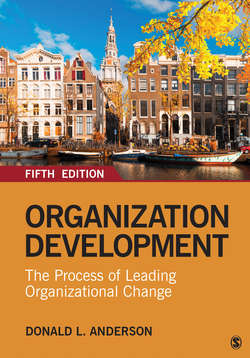Читать книгу Organization Development - Donald L. Anderson - Страница 71
На сайте Литреса книга снята с продажи.
The Nadler-Tushman Congruence Model
ОглавлениеNoting that systems theory is “too abstract to be used for day-to-day organizational behavior-problem analysis” (Nadler & Tushman, 1983, p. 114), Nadler and Tushman have offered an expanded version of systems theory that contains additional concepts intended to be more useful to practitioners (see Figure 4.3). Nadler (1981) also explains that this model is particularly useful for organizational change. The premise behind the model is this:
The model puts its greatest emphasis on the transformation process and in particular reflects the critical system property of interdependence. It views organizations as made up of components or parts which interact with each other. These components exist in states of relative balance, consistency, or “fit” with each other. The different parts of an organization can fit well together and thus function effectively, or fit poorly, thus leading to problems, dysfunctions, or performance below potential. Given the central nature of these “fits” among components in the model, we will talk about it as a congruence model of organizational behavior, since effectiveness is a function of the congruence among the various components. (Nadler & Tushman, 1983, p. 114)
Like the traditional model of systems theory described earlier, notice that inputs, transformation processes, outputs, and feedback are also included as part of the congruence model. Each of these has been expanded in this model. Inputs include environment, resources, and history, and are merged with organizational strategy to influence transformation processes. Market demands, human resources, technology, capital, information, and prior patterns all comprise the organization’s inputs. Strategy is included in the congruence model as it determines what the organization will work on and how the organization must work to achieve its outputs. Outputs are now more specifically defined not only as the “tangible” product of the organization’s processes, but outputs also consist of organizational, group, and individual performance. Nadler and Tushman include job satisfaction, stress, and other individual outputs as products of the work environment as well. Transformation processes have been expanded in the congruence model to include four important elements that relate to one another: task, individual, formal organizational arrangements, and informal organization. The task component encompasses the work to be done, but also the skills and knowledge required to do it and the degree of independence or judgment required. The individual component includes employees’ knowledge and skills, engagement and motivation, preferences and attitudes, and other influences on individual behavior. Formal organizational arrangements include explicitly defined processes and organizational structures, job definition, metrics, the physical layout and environment, and other officially specified aspects of the work. Informal organization is defined as the less explicitly defined or tacit understandings, processes, methods, and norms that comprise how work is actually done.
Description
Figure 4.3 The Nadler-Tushman Congruence Model
Source: Nadler, D. A., & Tushman, M. L. (1997). Competing by Design. Oxford, p. 38.
Together, these four elements are defined as the primary components of the organization. They interact together in more or less consistent ways as the organization produces its outputs. Nadler (1981) writes about a fundamental notion of the congruence model:
At the core of this systems-based perspective is the assumption that the interaction among the organizational components is perhaps more critical than the characteristics of the components themselves, and that as systems, organizations fundamentally work better when the pieces fit together. (p. 194)
Nadler and Tushman (1983) refer to this as the “congruence hypothesis,” or the idea that the better the congruence between components, the more effective the organization. When an organization has a market demand to produce a new product (new input and new output), that demand requires a specific task to produce the output. If the task’s demands require skills and knowledge that individuals do not possess, then there will be a congruence gap (or low “fit”) between task and individuals. Organizational effectiveness can be achieved only if the fit is increased.
The model points to areas that affect one another so that changes in other parts of the system can be noted and controlled. Nadler (1981) explains that when parts of a system are changed, they may increase or decrease the “fit” or congruence with other parts of the system. When change happens, other components of the organization may resist the change and encourage regression to the prior state. Thus, Nadler points to the need to motivate change (the individual component), manage transitions, and pay attention to political dynamics of change as well.
